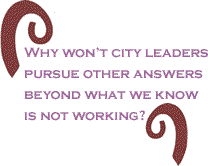
|
|||||||||||||||||||||
 |
|||||||||||||||||||||
 |
|
|
The City of Los Angeles is still trying to figure out its violence problem. The Mayor of Los Angeles has gone to Washington (twice) to seek more federal funds—gone to Sacramento to get the Govenator to help him terminate violence in Los Angeles. The request? More money for more cops. Every time L.A. is put to the test of how to make the city safer, it gives the same answer. More resources for suppression. The city usually gets the money. But the city doesn’t get any safer. Gang membership doesn’t go down. After more than twenty years of being near (or at) the top of America’s Most Violent City list, you would think the city would develop another answer—a more innovative response with a greater basis for resolution. Nope. The only answer that city officials can come up with is more cops, more weaponry, more jails, more strict “lock ‘em up and throw ‘em away” laws—in essence, more suppression. Even after they’re given another answer—one that makes more sense, one that has produced greater results in other cities and certainly could produce greater results in L.A., city officials have not been responsive to doing anything different than what they’ve done before. They say the definition of insanity is “doing the same thing and expecting a different result". More than a month after the Rice Report was presented to a Los Angeles City Council Ad Hoc Committee, not a single recommendation in the report has been followed. In fact, nothing has been done, and the only response to request for help, has been suppression support. Suppression alone can’t do it. There is another answer. The question is, why won’t city leaders pursue other answers beyond what we know is not working? Solutions to youth violence don’t have to be an “either/or” proposition. It now appears evident that the city just wants to treat it like one. Los Angeles will never pass the violence prevention test for as long as it only has one answer, suppression, to a problem that requires a broader, more comprehensive approach. So, what gives? There are really no more excuses for Los Angeles’ lack of responsiveness to violence. Atty. Connie Rice did what you asked her to do—study the problem, bring back some possible solutions. Well, she more than studied the problem. She deciphered the city’s organizational dysfunction. One that spends $82 million dollars to address 700 gangs and 40,000 gangs members with 61 interventionists. The city budgets a total of $958 million between the city council, the mayor, LAUSD and county government spread over some 78 departments and programs whose org chart looks like a maze of madness instead of a municipal approach to violence prevention. Most of the money never escapes the bureaucracy. As a result, Los Angeles spends 27 cents a day per gang member for intervention, and 24 cents a day per child (of the 300,000 children trapped in the hottest, most dangerous parts of the city, called “gang zones”) for prevention. Yeah, it’s like that, and I’m puttin’ the city on blast. Meanwhile, of the $82 million dollars (a mere pittance for a problem called by experts as an “entrenched epidemic”), $56 million goes to suppression and $4 million goes to prevention. What has it gotten us? Well, over the past ten years, Los Angeles has had over 100,000 shootings, 12,000 homicides and locked up 450,000 youth in local jails and youth detention facilities. We should be safer, right? But consider now, there are six times as many gangs, and twice as many gang members as there were ten years ago. What does that say about suppression as the answer to violence prevention? It says that suppression is not the answer.
Suppression can serve as an appropriate supplement to a more comprehensive approach to violence prevention. “Comprehensive approach.” Did I say something that the city hasn’t heard before? Comprehensive approach is something that the study called for. Comprehensive approach is a different answer to violence in Los Angeles. Suppression hasn’t even proved to be a partial answer to violence in L.A. But we know it has not proven to be the total solution. So, why are the governmental leaders resisting other courses of action? Is it really about the money? Other cities have made the investment, and are deriving returns on their investment. What’s stopping L.A.? We can’t possibility be that out of touch with best practices of other cities. Are we? If the city is truly in a violence crisis, and it is evident that we are, it would seem that responsible municipal government would be anxiously seeking opportunities to arrest this crisis. We must look at all the options on the table and pursue all answers that make sense. Can we truly say that this has been done? No, we cannot. In one specific instance, we know the City of Los Angeles has a study that has laid out some of the answers. Answers the city has not tried yet. When asked, why? There is just silence. In this instance, silence is not golden. Silence is detrimental to the well-being of the city. I urge city leaders to speak up on the issue of youth violence prevention, and we all suggest that the city look at options beyond suppression to address this issue. Suppression alone is not the answer. There is another answer. It’s right in front of you, in the Rice Report. More money for prevention. Less money for administrative waste. Start there. BC columnist Anthony Asadullah Samad is a national columnist, managing director of the Urban Issues Forum and author of the upcoming book, Saving The Race: Empowerment Through Wisdom. His Website is www.AnthonySamad.com. Click here to contact Mr. Samad. |
|
| Home | |
| March
1,
2007 Issue 219 |
||||||||||||||
|
||||||||||||||
| Printer Friendly Version in resizeable plain text format | ||||||||||||||
 |
||||||||||||||
|
||||||||||||||
 |
||||||||||||||
 |
||||||||||||||
 |
||||||||||||||
| |
||||||||||||||
| |
||||||||||||||






























